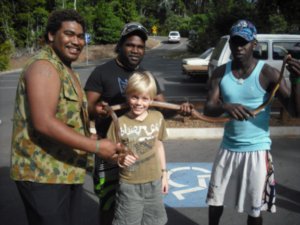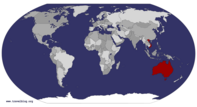Advertisement

 Brown tree snake
Brown tree snake
Please hold that head tight!We headed out of Cooktown on the very flash Mulligan Highway, built in 2006, which follows the old Cooktown-Developmental Road and connects Cooktown with Mareeba. We stopped briefly at James Earl Lookout, just south of Lakeland, and then had sausages for lunch in Mareeba. We continued south on the Kennedy Highway, then near Tolga, took the turn-off to Kauri and Tinaroo. We stopped at the Tinaroo Dam spillway and then drove into Danbulla National Park and State Forest to camp at Downfall Creek camp ground. Our camp site had a great view of Lake Tinaroo and allowed fires, although you had to bring your own wood. As we had arrived on Friday afternoon, the camp ground was filling up with weekend campers, but it never got rowdy - perhaps the light rain that began falling kept some people away. There was plenty of bird life, including a number of laughing kookaburras that snatched food from more than one camp site while we were there.
On Saturday morning, we did the easy 4.6 km 'Regeneration Walk' from Downfall Creek to Kauri Creek and back. Mark got 'hooked' a couple of times by 'Lawyer Vines' (also known as 'Barbwire Vines' or 'Wait-a-while')
that seem to be prolific in this part of the world. Fortunately, this species of the Calamus genus, I think Calamus caryotoides, only had small 'grappling hooks' on their new spikes and weren't nearly as bad as some other varieties of these plants we had seen elsewhere in northeast Queensland.
After lunch, we headed out on the “Danbulla Forest Drive” that takes you around Lake Tinaroo. We stopped to have a look at Lake Euramoo (an extinct volcanic crater lake), The Chimneys (remains of an early 20th century settlement), Mobo Creek Crater, and the huge Cathedral Fig Tree. After that, we continued on to Crater Lakes National Park - Lake Barrine section, Crater Lakes National Park - Lake Eacham section, the town of Yungaburra, Curtain Fig National Park, and then drove into Atherton.
While viewing Lake Eacham we heard quite a commotion coming from a group of youths in the Men's toilet. It turned out that they were trying to capture a 2 metre long snake that had made its home in the ceiling of the toilet. They eventually grabbed hold of it, assuring us that it was harmless but would still give a nasty bite and might

 Hotel Tully Falls, Ravenshoe
Hotel Tully Falls, Ravenshoe
Qld's highest pub in Qld's highest townscare people going to the loo. The snake was not cooperating very well with their attempts to grab it, but they eventually had it under control. Once they had it well under control, Thomas decided to have his photo taken with it. One of the youths said it was a harmless 'red-bellied' python but could still give a good bite. Although it had a red tinge to its belly, it didn't look much like a python to us. I also couldn't find any python remotely similar in appearance to it on the web and began wondering after the fact if it was in fact a deadly Brown snake or Taipan! We later had it identified as a Brown tree snake (Boiga irregularis) by Steve from the Bedrock Village Caravan Park in Mt Surprise. Steve has worked in a number of reptile and animal parks and told us how these tree snakes are now a big menace on the Pacific island of Guam where they were decimating the native bird population. It is thought that shortly after World War II the Brown tree snake was accidentally transported from its native range in the South Pacific to Guam, probably as a stowaway

 Millstream Falls
Millstream Falls
Australia's widest waterfallin ship or aircraft cargo. It has since become a major nuisance, by the sounds of it - Wikipedia has more on this. According to Wikipedia's description of its venom, “The Brown tree snake is a nocturnal snake that can be very aggressive when confronted. It is a rear-fanged colubrid, possessing two small, grooved fangs at the rear of the mouth. Due to the placement of the fangs and grooved rather than hollow fangs, the venom is difficult to convey into a bite on a human, thus is only given in small doses. The venom appears to be weakly neurotoxic and possibly cytotoxic with localized effects, but these effects are trivial for adult humans, and serious medical consequences have been limited to children due to their low mass. This snake is still not considered dangerous to an adult human. The venom seems to be primarily used to subdue lizards, which are more easily positioned in the rear of the mouth for venom delivery.” We definitely can vouch for it being aggressive when trying to be captured!
On the way back to the camp ground, we found a good sized tree branch lying on the side of the road, so
that night we had a camp fire, our first since Fraser Island back in April. Steak over a camp fire just has a special taste to it. Yum! It began raining overnight and continued during our pack up the next morning.
On Sunday we drove south on the Kennedy Highway to Mt Hypipamee National Park and, despite the light rain falling, walked to The Crater and Dinner Falls. Then we headed across to Malanda and found a sheltered picnic area at Malanda Falls where we had lunch. Afterwards we drove out to the Nerada tea plantation and factory, and then travelled south on the Millaa Millaa- Malanda Road where we decided to set up camp for a couple of nights at the Millaa Millaa Tourist Park. It was still quite early after we had set up camp, so we drove out on the short waterfall circuit to Millaa Millaa Falls, Zillie Falls and Elinjaa Falls. Back at the caravan park, it began raining again and a cold wind was blowing, so we zipped on all the walls of our annexe. We have often put up the awning and perhaps one or two of the end walls if it is
raining, but this is probably the first time we had to erect the full annexe since Kosciuszko National Park. The park had advertised that you were likely to see Tree Kangaroos here, so Thomas and Mark went in search of them in a rainforest-like section. However, it was drizzling, very dark and we discovered that they hadn't been seen in the park for several months, so we had no luck.
On Monday we drove a bit further afield in search of waterfalls, this time to the Palmerston Section of Wooroonooran National Park. We first stopped at Henrietta Creek and walked 1.7 km to Silver Creek and Nandroya Falls. Mark continued on the circuit walk for another 3.6 km while the rest of the kersers mob were “fed up with leeches” (Thomas received his first blood-sucking leech bite on the way to the falls), so decided to take the shorter, direct route back. Apparently Tree Kangaroos have been seen on this walk, but again we had no luck in that regard, although there were plenty of Eastern Whipbirds calling to one another. From there we drove down to Crawfords Lookout and then did the short walks to Wallicher Falls and
Tchupala Falls from the highway. On the way back to Millaa Millaa we stopped and had a look at Mungalli Falls before stopping for yummy treats at the Mungalli Creek Dairy, which uses bio-dynamic farming principles. Not long after we got back to the camp site, it began raining in earnest and didn't seem to let up all night.
On Tuesday we packed up camp and headed along the Palmerston Highway in the other direction - ie. towards Ravenshoe. Not long after leaving Millaa Millaa we glimpsed a Tree Kangaroo crossing the road. Despite the numerous waterfalls we had seen in the previous few days, Thomas was keen to see some more, so we stopped briefly at Souita and Pepina Falls, which only required short diversions off the highway. We then drove into Queensland's highest town, Ravenshoe, situated at an elevation of 916 metres (3003 ft). At the Visitor Centre, Thomas noticed that one of the postcards for sale, which had pictures of five of the waterfalls in the region, had one of the falls incorrectly labelled as Tchupala Falls, whereas he was adamant that it was the nearby Wallicher Falls instead. When Thomas pointed this out to Ben

 Downfall Creek campsite
Downfall Creek campsite
Overlooking Lake Tinarooat the Visitor Centre, Ben was so impressed with Thomas' powers of observation that he gave him the postcard for free! Ben also gave us a Pomelo, a grapefruit-like citrus fruit, to try out. Apparently the grapefruit is a result of an orange-pomelo cross. The pomelo is meant to be quite sweet when ripe, but ours must have been a bit unripe because it was still a bit sour, similar to a grapefruit.
From Ravenshoe, we visited Little Millstream Falls, just out of town, and then drove along the Kennedy Highway to Australia's widest waterfall, Millstream Falls. From here we decided to stay the night at Mt Surprise Tourist Park.
Advertisement
Tot: 0.131s; Tpl: 0.016s; cc: 10; qc: 53; dbt: 0.0813s; 1; m:domysql w:travelblog (10.17.0.13); sld: 1;
; mem: 1.2mb






















